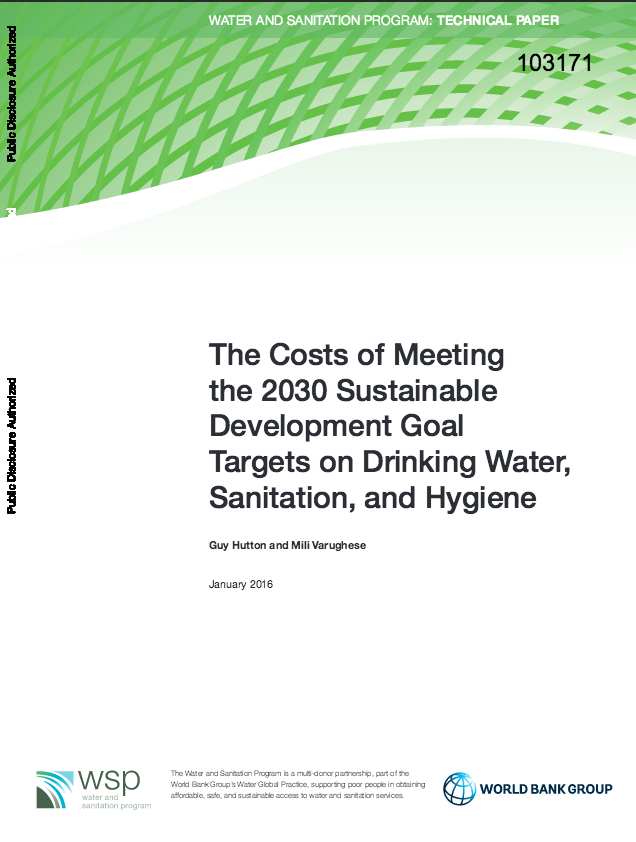If resources are targeted to the underserved, current financing levels can cover the costs of achieving universal basic service for drinking water, sanitation and hygiene (WASH) by 2030, according to a report by the World Bank.
However, to achieve the "enhanced level of service" reflected in the Sustainable Development Goals' (SDGs) targets on WASH, the report finds that current investment levels will need to triple, service will need to be more efficient, and institutions will need strengthening.
 12 February 2016: If resources are targeted to the underserved, current financing levels can cover the costs of achieving universal basic service for drinking water, sanitation and hygiene (WASH) by 2030, according to a report by the World Bank. However, to achieve the “enhanced level of service” reflected in the Sustainable Development Goals’ (SDGs) targets on WASH, the report finds that current investment levels will need to triple, service will need to be more efficient, and institutions will need strengthening.
12 February 2016: If resources are targeted to the underserved, current financing levels can cover the costs of achieving universal basic service for drinking water, sanitation and hygiene (WASH) by 2030, according to a report by the World Bank. However, to achieve the “enhanced level of service” reflected in the Sustainable Development Goals’ (SDGs) targets on WASH, the report finds that current investment levels will need to triple, service will need to be more efficient, and institutions will need strengthening.
‘The Costs of Meeting the 2030 SDG Targets on Drinking Water, Sanitation and Hygiene’ analyzes the capital costs of meeting SDG Targets 6.1 and 6.2. The report is the outcome of a collaborative study by the World Bank’s Water and Sanitation Program (WSP) and the World Health Organization and the UN Children’s Fund’s (WHO/ UNICEF) Joint Monitoring Programme for Water Supply and Sanitation and other partners.
The report finds that the costs of extending basic WASH services to the underserved is roughly equivalent to the financial resources spent on improving water supply and sanitation during the Millennium Development Goals (MDGs) period. But, it cautions, estimates hide variations across countries and income groups. For example, “significantly greater capital spending” is needed in Sub-Saharan Africa and in Southern Asia, and more than half of the capital costs need to be spent on providing WASH services to the two poorest quintiles. Further, as urbanization trends increase, WASH financing and interventions will increasingly need to focus on urban areas, according to the report.
The report considers different pathways for achieving the WASH-related SDG targets. One pathway is to address more affordable, lower-level services first. Another option is to immediately undertake financially and technically intensive higher-level services. Finding a balance between the two pathways is the report’s recommended approach. It calls on donors and public financiers to rethink which countries and populations they will support, which may mean making a choice between bringing better services to those with basic services, or achieving basic WASH for the underserved.
“Countries need to assess the best way to spend their resources, which infrastructure to build, how to operate the services, what funds are available, and what tariff structure to adopt while also remaining sensitive to affordability,” said Jyoti Shukla, WSP. He said institutional strengthening is fundamental to ensure that investments translate into effective service delivery over time.
Achieving the WASH-related SDGs will require greater financial investments over time because of the cost of operating new infrastructure and maintaining operations and maintenance, according to the report. To ensure efficient, quality spending, the report recommends strengthening institutions and regulations, including through tariff policies. The report also points out significant economic and environmental benefits of achieving the SDG targets on WASH. [World Bank Press Release] [Publication: The Costs of Meeting the 2030 SDG Targets on Drinking Water, Sanitation and Hygiene] [Summary Report] [WSP Website] [WHO/UNICEF Joint Monitoring Programme]